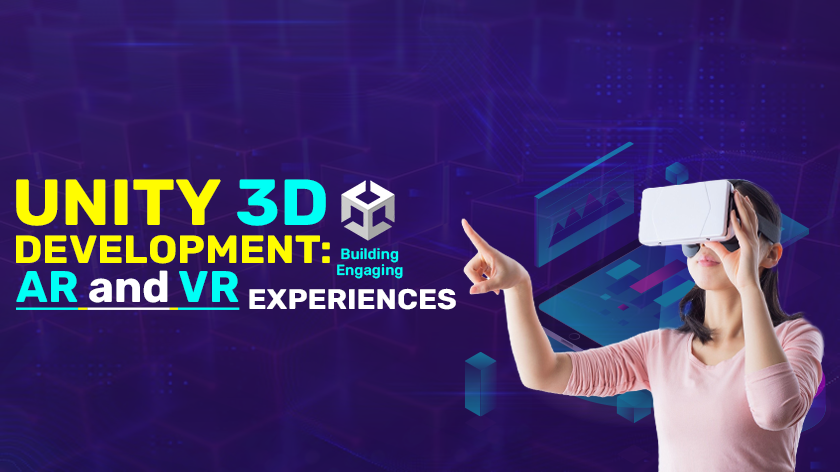The way we engage with digital content has altered significantly as a result of augmented reality (AR) and virtual reality (VR). A popular tool for creating engaging AR and VR applications is Unity 3D, a powerful and adaptable game development engine. This article will discuss Unity 3D’s main benefits, how it makes creating these experiences easier, and advice for developers who want to use this platform.
Understanding Unity 3D
The cross-platform game engine Unity 3D provides a dependable environment for creating 2D and 3D apps. Unity’s user-friendly interface and vast asset store make it accessible to developers of all experience levels. In addition, it ensures wide user accessibility by enabling the development of AR and VR experiences across several platforms, including mobile devices, desktop PCs, and VR headsets.
Key Features of Unity for AR and VR Development
- Real-Time Rendering: Unity’s real-time rendering capabilities ensure that users experience smooth and immersive environments. This is critical for AR and VR applications where lag can disrupt the user experience.
- Asset Store: A large number of assets, including 3D models, animations, sound effects, and plugins, are available through the Unity Asset Store. These resources can be used by developers to improve their work and save time.
- Cross-Platform Compatibility: With Unity, developers can create apps for a variety of operating systems, such as iOS, Android, Oculus Rift, HTC Vive, and more. Wider dissemination and accessibility are made possible by this adaptability.
- Integrated Development Environment (IDE): Unity provides an intuitive IDE that streamlines the development process. Developers can easily manage scenes, scripts, and assets, making it simpler to create complex AR and VR experiences.
Why Choose Unity for AR and VR Development?
- Community Support: The large and active Unity developer community provides a wealth of resources, including instructions, forums, and tools for resolving bugs. This working atmosphere is beneficial for both new and experienced developers.
- Frequent Updates: Unity is updated often with new features and improvements. Because of this dedication to innovation, developers will always have access to the newest equipment and software to create cutting-edge AR and VR experiences.
- AR and VR Toolkits: Unity provides specific tools that make the process of creating AR and VR apps easier, such as the XR Interface Toolkit and AR Framework. With the help of these toolkits, developers can focus on creativity rather than technical challenges because they come with built-in elements and features.
Creating engaging AR and VR experiences
Creating captivating AR and VR experiences calls for a blend of technological know-how, creativity, and user behavior insight. The following is some vital advice for developers:
1. Start with a Strong Concept: Create a captivating and distinct concept for your AR or VR experience before starting development. Think about the application’s goal and the way users will engage with it. Every design and development decision is based on a clearly defined concept.
2. Prioritize User Experience (UX): In AR and VR applications, the user experience is crucial. Create controls that are easy to use and make sure that interactions are organic. To get input and make the required changes to improve usability, conduct user testing.
3. Optimize Performance: Performance is critical in AR and VR. Ensure that your application runs smoothly across devices by optimizing graphics, reducing polygon counts, and minimizing unnecessary assets. Regularly test the application on target devices to identify and resolve performance issues.
4. Leverage interactive elements: Incorporate interactive elements to engage users. Use triggers, animations, and gamification techniques to encourage exploration and interaction. within the virtual environment. The more users can interact with the experience, the more engaging it will be.
5. Utilize Audio and Visual Effects: High-quality audio and visual effects can significantly enhance the immersion of AR and VR experiences. Use spatial audio to create a sense of presence and ensure that visual elements are polished and cohesive.
6. Stay updated with trends: The AR and VR landscape is constantly evolving. Stay informed about the latest trends and technologies to ensure that your applications remain relevant and innovative. Engage with the Unity community and follow industry leaders to keep abreast of advancements.
Conclusion: Empower Your AR and VR Projects with Unity
Unity 3D is an effective tool for creating immersive AR and VR experiences, providing creators with the tools and adaptability they need to realize their visions. Developers may produce engaging apps that connect with consumers by focusing on user experience, streamlining performance, and utilizing Unity’s wealth of features. Unity continues to be at the forefront of AR and VR technology advancements, enabling developers to push the envelope of immersive experiences.
Are you ready to bring to life your ideas for AR and VR? At XcelTec, we’re experts at using cutting-edge software like Unity 3D to create immersive AR and VR experiences. Our team of experts is here to assist you in creating attractive and effective applications, whether you’re creating virtual reality (VR) devices, desktop programs, or mobile apps. Contact XcelTec today and transform your vision into reality!
For more information: https://www.xceltec.com/
 :
https://www.pinterest.com/xceltec0192/
:
https://www.pinterest.com/xceltec0192/












